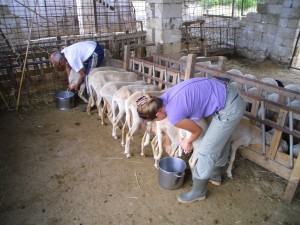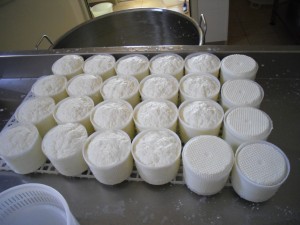When I turned to Professor Google for tips on “how to milk a sheep” during my novice days, the results were pretty thin. So here’s what I can tell you:
-
It’s easiest if you have a head gate or even a rope to keep the sheep in one place. The less they can move about, the better. And of course a bit of delicious grain to keep the sheep happy and distracted. However feeding will encourage… well, see #3.
-
A deep milking pot is best to catch the milk. The sheep may wiggle around and pick up its back feet as you work. A shallow dish is just begging to be stepped in or kicked over.
-
A sheep will eventually poop in your milk pot. You will learn to recognize when this is about to happen and be able to whisk the pot away. In the beginning, however, when you are intensely focused and milk is pretty hard-won, it can be a bit devastating. For this reason, it’s nice to have another pot or jar with filter (cheesecloth) handy where you can frequently empty your milking pot.
-
Udder cleaning… well, it’s up to you. The milking I did was for cheese, and it got filtered over and over — first through cheese cloth, then twice through a tiny mesh filter, then again after heating through a wire kitchen strainer. We didn’t clean all 60 udders twice a day. To each their own!
-

In the back on the left you can see the master at work. In the foreground is me trying the from-the-side approach. I switched to straddling the sheep the following day.
You can sit behind the sheep on a stool. Or you can stand, face the opposite direction of the sheep, and bend over to reach the udder. For me, a 5’7” (170cm) person, the position that combined most milk with best ergonomics was the latter – straddling the sheep. This method has the added benefit of being able to milk the sheep anywhere – not just at your milking station.
- Pull the udder back between the sheep’s legs. You have to develop a feel for where on earth the milk is. It’s important to manipulate more than just the teat. Grasp the udder above the teats and let the teats stick out the bottom of your grip.
-
Upward pressure is important. It’s my personal observation that this is how lambs drink. Orphaned lambs will unintentionally bash you in the chin with their heads if you hold them while bottle feeding as they search for the nipple. A lamb with its mother practically brutalizes the udder with its skull in the search for milk.
-
With your hands on the udder (you will slowly develop a feel for where to grasp via trial and error), teats sticking out the bottom of your grip, and pressure up into the sheep’s body, tighten one of your fists from top to bottom to force the milk down into and out the bottom of the teat. This can feel like trying to get toothpaste out of a half empty tube one-handed.
-
Now repeat on the opposite side. Repeat until udder is mostly empty (if you’re good), until you’re exhausted/frustrated (if you’re new), or until the ewe’s milk disappears (I’m told this happens if they get too stressed about the milking).
-
If all you get is a dribble or a pinhole stream, try using both hands on one teat, switching back and forth every few squeezes. Once you’ve achieved a more squirt-gun-like stream, you’ll know what you’re eventually aiming to achieve one handed.
-
Every udder is different, so some are far more difficult than others. If this is your very first time, try several sheep before you even think about getting discouraged. It took me ten minutes to milk my first sheep, and I probably didn’t get even half the milk out (a half-liter/2c. per milking session [2 daily] was the farm average). Five days into my milking tenure, I’d cut my time (and frustration!) in half — to five minutes. The farm hot-shot with decades of milking under his belt can polish off an udder in about twenty seconds!
-
You don’t have to get every last drop of milk out of an udder. My observations of a hand-milking expert tell me that it’s not worth your time to get more than the first “easy” two cups (1/2 liter). [Note: a few sheep gave a whole liter per milking!]. Apparently it doesn’t hurt to leave some behind, as long as you’ve relieved the pressure! True, you may be able to eek out a bit more, but it will take twice as long as the large volume that comes easily.
That’s it! Hope this helps, and happy milking!
For sheep chessemaking recipes, check out: How to Make Cheese with Sheep’s Milk.







Hi Jema — I’m a fiction writer, and I’m writing a scene where my hero milks a sheep. Your guide is super helpful. : ) You write that you will learn to recognise when the sheep is about to poop in the bucket. What are the signs? It will make a nice little moment in my story. Thanks so much!
Hi! I’m not able to take the time to craft a description for you, but I bet youtube might have milking videos where you could watch and see? Good luck with your scene!
At what point after their first lambing do you start training them for milking?
I’m wondering how long sheep milk is good after you mill the sheep. Have a lamb in the house and no formula. Want to milk the colostrum for the babe…
Hi Portland – I don’t have a straight answer. All the sheep milk in my life was used really quickly. My unpasteruized cow’s milk lasts anywhere from a week to 10 days before it spoils. Temperature control is really important. If it’s at a temperature where bacteria multiply easily, it spoils much more quickly. Hope that gives you some clues!
Hi Portland, Sheeps milk freezes really well and can be kept for 12 months easily and up to 2 years in the freezer. Colostrum is fine for up to 12 months. In terms of fresh I think 3 days or 4 days max in the fridge.
Thank you for this, sheep milking information is hard to find!
So glad you found it helpful, Adelyn! 🙂
I am interested in raising sheep for milking (eventually) since we don’t need the volume of milk that a cow would produce, but I am having a hard time finding info on good milking breeds. I was wanting wool sheep anyway so I thought of I could milk them and have them sheared that would be a win win (maybe). Was curious as to what breed you are milking in the photos. Thanks
Hi Sarah, I’ve sent the farm an email. I’ll get back to you if they get back to me!
I have pure breed East friesian sheep for sale. The milk is amazing. You can call me at
615-987-2698. Thanks. Kevin Pickett.
I normally wouldn’t approve a comment like this, but I’m going with my gut and faith of goodness in humanity. 🙂
I originally want East Friesians but no one has them close enough to me. I need to be able to take the 2 ewes back-to-farm for breeding since I don’t have space for a ram. In the end I decided on Katahdin because they’re readily available and people *do* milk them!
Do you still have any females for sale.
Hi Kevin,
I came across your post about having milking sheep. Do you mind if I have a few questions? We live in Mississippi and I am looking for sheep to milk. Would you be close by? If not is shipping a possibility. What would you have available?
I would appreciate any help you may have in this endeavor.
Thanks.
Sincerely,
Tammy Regan
Foxworth, Mississippi
Hi, I am Helen from Nigeria. Ia m thinking of milking Yankasa hair sheep. It is a sheep native to Nigeria and lactates for 180 days but it has great milk solids and butterfat. Dairy production is virtually non existent here and I am trying for a micro dairy alongside raising a few zebu cows for milk and some West African Nigerian dwarf goats. Would it be okay to get a milking machine for 10 goats and 10 sheep. I don’t think I have the time and patience for hand milking. Which goat/sheep milker would you suggest? I am interested in a milker that is not expensive.
Hi Helen,
I don’t have any experience with milking machines, unfortunately. Perhaps another reader will chime in with a suggestion? You might also read one of these pages:
http://crazygoatlady.com/index.php/2010/06/24/milking-goats-worlds-best-kept-secret/
http://countrysidenetwork.com/daily/livestock/goats/goat-milking-machines-make-life-easier/
Hope that helps a bit!
Hi Helen – got this via email today. Another reader was having trouble posting:
Hi Helen, I’m really excited to read that you are milking in Nigeria as thats where I am milking too! I’ve milked local sheep and goats and would love to connect with you to share tips and swop ideas. Perhaps you’d like to email me? My email is [individuals now connected, requested email removed]. Hoping we can connect soon.
Katharine